Effective community infrastructure and resource management are crucial for sustainable urban growth in Cities: Skylines. This article explores the impact of infrastructure on connectivity and quality of life, the challenges of resource allocation, and the tools available for enhancing urban development. Key features like zoning and traffic management will be discussed, alongside strategies for balancing budgets and prioritizing public services. Understanding these elements can lead to more vibrant and efficient city environments.
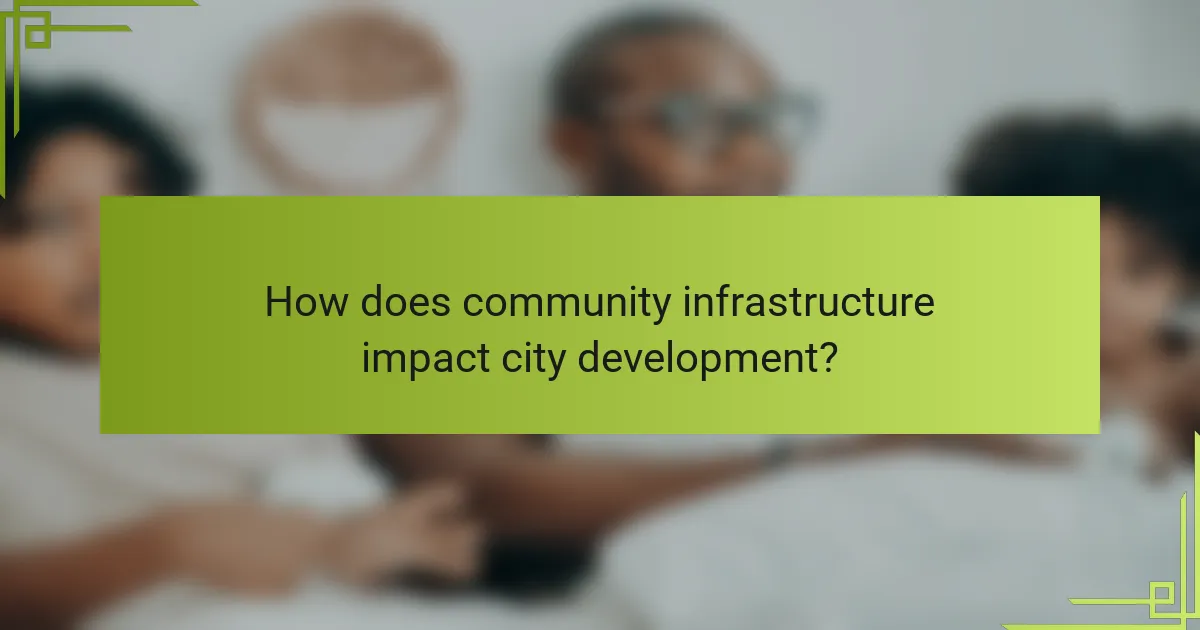
How does community infrastructure impact city development?
Community infrastructure significantly influences city development by enhancing connectivity, accessibility, and quality of life. Effective resource management ensures sustainable growth and efficient service delivery. Investment in infrastructure attracts businesses, fosters social interaction, and improves public health outcomes. As a result, cities with robust community infrastructure experience higher economic vitality and citizen satisfaction.
What are the essential components of community infrastructure?
Essential components of community infrastructure include transportation systems, utilities, public spaces, and social services. These elements work together to enhance the quality of life for residents and support sustainable development.
Transportation systems ensure efficient movement within the community, while utilities provide essential services like water and electricity. Public spaces foster social interaction and recreation, and social services address community needs such as education and healthcare. Each component plays a vital role in creating a cohesive and functional urban environment.
Why is public transport critical for urban planning?
Public transport is essential for urban planning as it enhances accessibility and reduces traffic congestion. Efficient public transport systems promote sustainable development by minimizing carbon footprints and improving air quality. They facilitate economic growth by connecting communities to jobs and services. Additionally, well-planned transport networks can lead to increased property values and urban revitalization. Investing in public transport infrastructure ultimately contributes to a more livable and resilient city.
How do parks and recreational areas enhance community well-being?
Parks and recreational areas significantly enhance community well-being by promoting physical activity, social interaction, and mental health. Access to green spaces encourages residents to engage in outdoor activities, which improves fitness levels and overall health.
These areas also serve as social hubs, fostering connections among community members. Events held in parks can strengthen community bonds and create a sense of belonging. Additionally, natural environments have been shown to reduce stress and improve mood, contributing to better mental health outcomes.
Research indicates that communities with ample recreational spaces experience lower rates of chronic diseases. For instance, neighborhoods with parks report higher physical activity levels among residents, leading to improved health metrics.
Overall, well-planned parks and recreational areas are essential for enhancing the quality of life in urban environments. They provide vital resources for health, social cohesion, and environmental benefits.

What are the challenges of resource management in urban settings?
Resource management in urban settings faces several challenges, including limited space, budget constraints, and diverse community needs. Effective infrastructure development requires balancing these factors.
Urban areas often struggle with resource allocation due to high population density. This leads to competition for essential services like water, energy, and waste management. Furthermore, aging infrastructure complicates maintenance and upgrades, increasing operational costs.
Budget limitations restrict investment in new technologies and sustainable practices. Cities must prioritize projects that yield the most significant impact, often leaving less critical needs unmet.
Diverse community needs create additional complexity. Urban planners must consider varying demographics and socioeconomic backgrounds when designing infrastructure. This requires extensive data analysis and community engagement to ensure equitable access to resources.
How do cities balance resource allocation among different sectors?
Cities effectively balance resource allocation among different sectors by prioritizing community needs and optimizing infrastructure. They analyze data on population density, economic activity, and service demand to allocate resources efficiently. Collaboration among departments ensures that essential services like healthcare, education, and transportation receive adequate funding and support.
Public feedback mechanisms allow citizens to voice concerns, guiding resource distribution. For example, cities may allocate more funds to public transport in densely populated areas to reduce congestion. Additionally, cities often employ technology for real-time monitoring, enabling dynamic adjustments to resource allocation based on current demands.
Sustainable practices are increasingly integrated into resource management, promoting long-term community welfare. This approach not only addresses immediate needs but also ensures future resilience against challenges like climate change.
What strategies can be employed to manage waste effectively?
To manage waste effectively, cities can implement strategies such as recycling programs, composting initiatives, and waste-to-energy technologies. These methods reduce landfill use and promote sustainability.
Recycling programs encourage residents to sort materials, increasing the recovery rate of resources. Composting initiatives transform organic waste into valuable soil amendments, reducing disposal costs. Waste-to-energy technologies convert non-recyclable waste into energy, providing a renewable power source.
Collaboration with local communities enhances participation in these strategies, ensuring a more sustainable urban environment. Regular education campaigns raise awareness about waste management and its benefits, fostering a culture of responsibility.
Investment in infrastructure, such as advanced waste sorting facilities and collection systems, streamlines waste management processes. These measures collectively contribute to more efficient resource management in urban settings.
How does energy management influence city sustainability?
Energy management significantly enhances city sustainability by optimizing resource use and reducing waste. Effective energy management leads to lower carbon emissions and improved public health. In Cities: Skylines, players can implement renewable energy sources, efficient transportation systems, and smart grid technology to create sustainable urban environments. These strategies not only conserve resources but also foster community engagement and economic growth. As a result, cities become more resilient and adaptable to environmental changes.
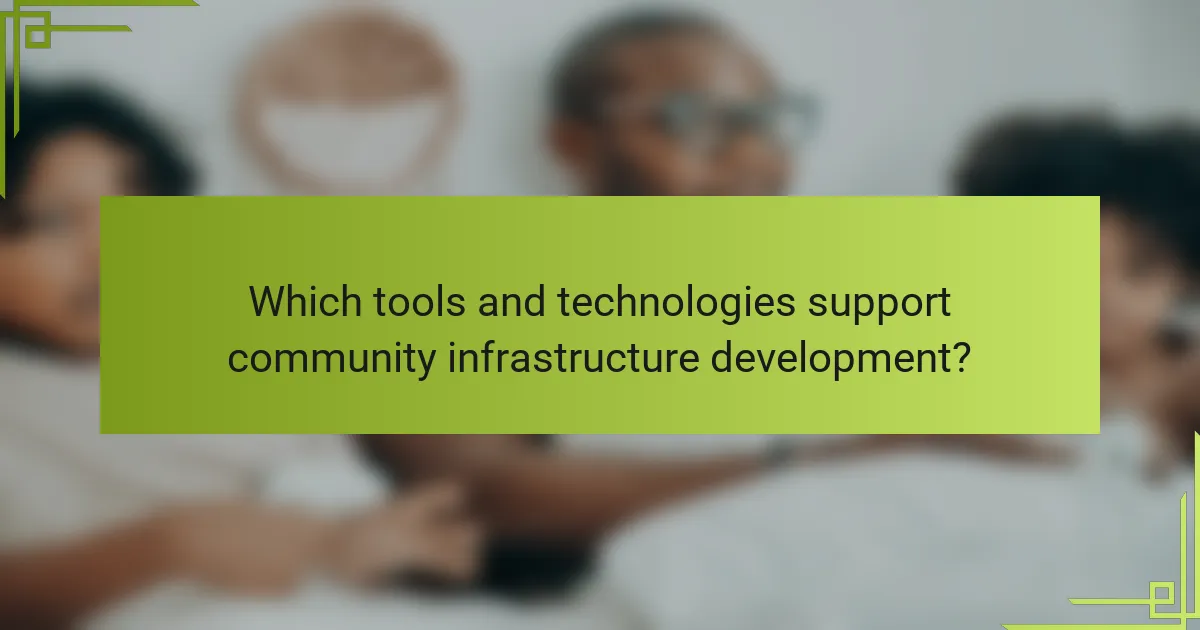
Which tools and technologies support community infrastructure development?
Cities: Skylines utilizes various tools and technologies to enhance community infrastructure development. Key components include advanced simulation engines, modding support, and comprehensive resource management systems.
Tools like the Asset Editor allow users to create custom buildings and infrastructure, while the Traffic Manager mod optimizes transportation networks. Additionally, the game features data overlays for analyzing community needs, such as water and power demand.
Technologies such as procedural generation enable diverse urban layouts, while community-driven content expands gameplay possibilities. These elements work together to create a dynamic environment for managing urban growth and resource allocation.
What role does simulation software play in urban planning?
Simulation software significantly enhances urban planning by allowing for detailed modeling of community infrastructure and resource management. In “Cities: Skylines,” users can visualize urban development scenarios, assess the impact of zoning decisions, and optimize resource allocation. This software enables planners to experiment with various layouts and policies, promoting sustainable growth and efficient service delivery. By simulating real-world conditions, planners can make informed decisions that improve community resilience and quality of life.
How can data analytics optimize resource management?
Data analytics can significantly enhance resource management in Cities: Skylines by providing insights into community needs and optimizing service delivery. By analyzing traffic patterns, population density, and resource consumption, players can make data-driven decisions to allocate resources more effectively.
For instance, using analytics, players can identify areas with high demand for public services and adjust infrastructure accordingly. This leads to improved citizen satisfaction and efficient use of resources. Furthermore, predictive analytics can forecast future needs based on current trends, allowing for proactive planning rather than reactive measures.
Ultimately, integrating data analytics into resource management strategies fosters sustainable urban development and better community infrastructure in the game.
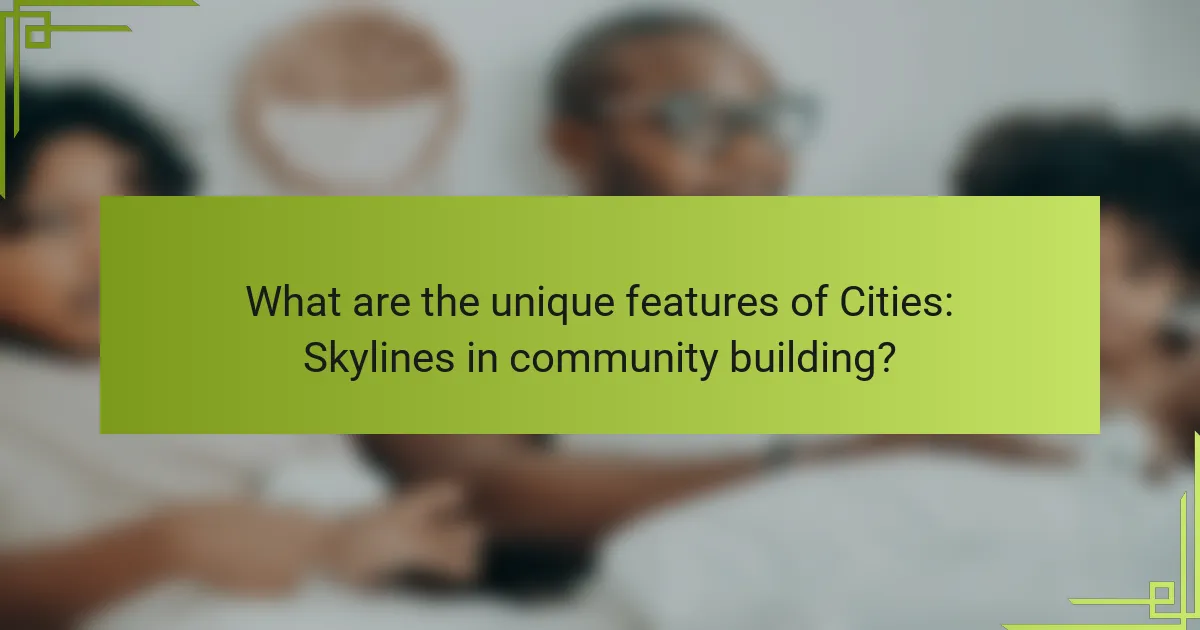
What are the unique features of Cities: Skylines in community building?
Cities: Skylines offers unique features that enhance community building through detailed infrastructure and resource management. The game’s simulation allows players to design intricate urban layouts, manage public services, and address citizens’ needs effectively.
One standout feature is the zoning system, which enables players to designate areas for residential, commercial, and industrial use. This directly influences population growth and economic development. Another unique aspect is the traffic management system, which provides tools for optimizing transportation networks, reducing congestion, and improving accessibility.
The game also incorporates a dynamic economy, where players must balance budgets while investing in community projects. This adds depth to resource management, requiring strategic planning to enhance community welfare. Finally, mod support allows for user-generated content, fostering creativity and expanding gameplay possibilities.
How does modding enhance gameplay and community engagement?
Modding enhances gameplay and community engagement by allowing players to customize experiences and share creations. It fosters creativity and collaboration, leading to diverse content that enriches the game. Players can develop unique infrastructure and resource management strategies, enhancing the overall enjoyment and longevity of Cities: Skylines. Modding strengthens community bonds as users discuss, rate, and support each other’s modifications. This interaction creates a vibrant ecosystem where ideas flourish and gameplay evolves continuously.
What are the benefits of user-generated content in urban simulation?
User-generated content enhances urban simulation by fostering community engagement and improving resource management. It allows players to share strategies and ideas, leading to innovative urban designs. Collaboration through user content helps identify common challenges and solutions, enhancing the overall gaming experience. Additionally, this content can provide valuable insights into player preferences, guiding developers in future updates and features.
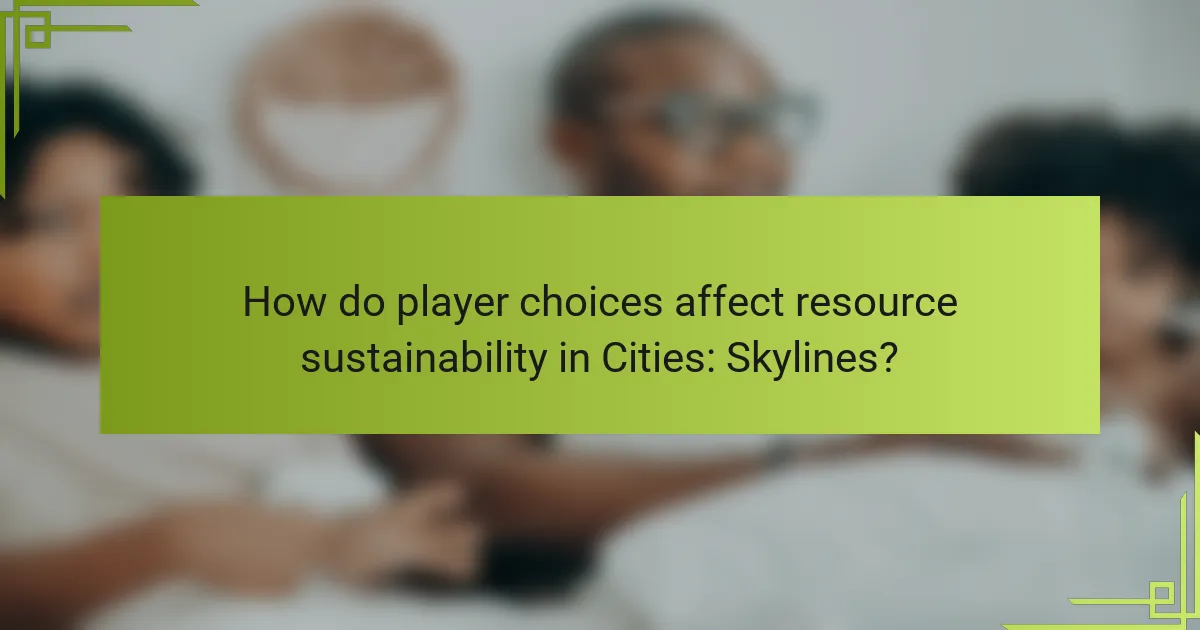
How do player choices affect resource sustainability in Cities: Skylines?
Player choices significantly influence resource sustainability in Cities: Skylines by determining infrastructure development and management strategies. Strategic decisions on zoning, transportation, and energy sources directly impact resource consumption and environmental effects. For instance, prioritizing public transport reduces traffic congestion and emissions, enhancing sustainability. Conversely, neglecting waste management can lead to pollution and resource depletion. Balancing growth with resource conservation is crucial for long-term city viability. Players must consider the ecological footprint of their choices to foster sustainable urban environments.
What are the consequences of neglecting public services?
Neglecting public services leads to severe consequences for cities, including decreased quality of life, increased health risks, and economic decline. Poor infrastructure results in traffic congestion, inadequate waste management, and limited access to essential services. As a result, residents may face heightened frustration and decreased community engagement. Furthermore, neglect can lead to reduced property values and deter new businesses from investing in the area, ultimately harming local economies.
How can players implement eco-friendly policies effectively?
Players can implement eco-friendly policies effectively by prioritizing sustainable infrastructure and resource management. Focus on renewable energy sources, such as wind and solar, to reduce pollution. Encourage public transportation systems to minimize traffic congestion and emissions. Implement waste management strategies that promote recycling and composting. Foster green spaces to enhance biodiversity and improve residents’ quality of life. Engage the community in environmental initiatives, creating a sense of ownership and responsibility.
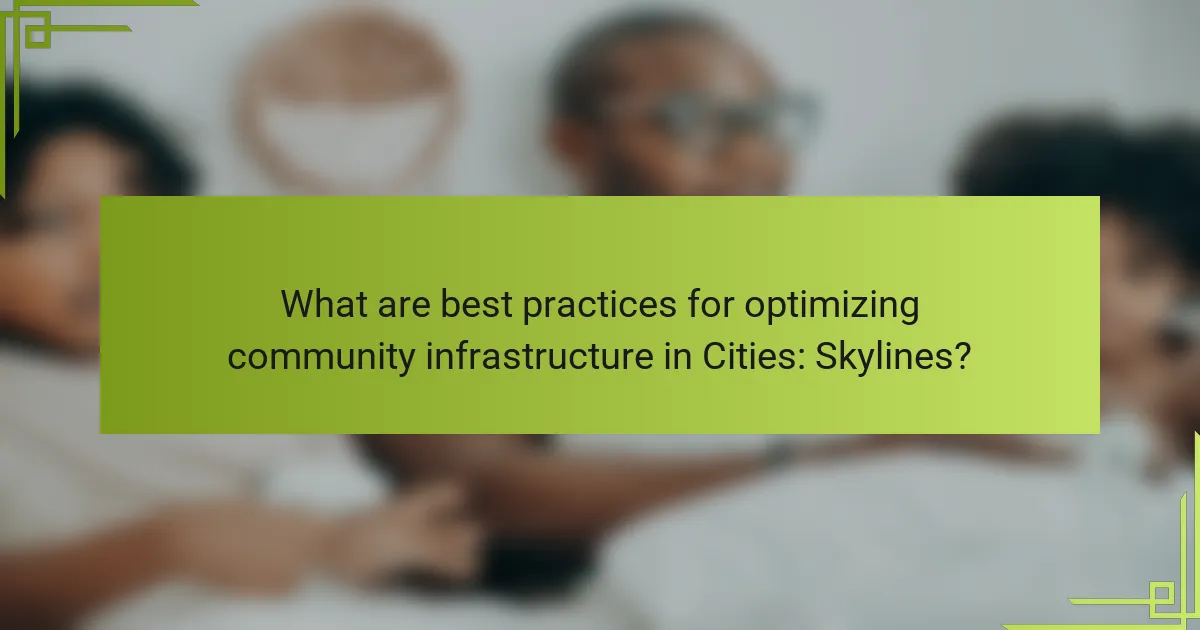
What are best practices for optimizing community infrastructure in Cities: Skylines?
To optimize community infrastructure in Cities: Skylines, focus on efficient resource management, zoning, and transportation. Prioritize public services, such as healthcare and education, to enhance citizen satisfaction. Implement a balanced budget to ensure sustainable growth. Use road networks to improve accessibility, reducing traffic congestion. Regularly assess and adjust policies based on community feedback and needs.
What common mistakes should players avoid when developing cities?
Players should avoid common mistakes like neglecting public transport, overbuilding, and ignoring citizen needs. Effective community infrastructure and resource management are crucial for city development.
Neglecting public transport leads to traffic congestion. Ensure efficient transport options to connect neighborhoods. Overbuilding can strain resources, causing issues like waste management problems. Balance growth with infrastructure capacity. Ignoring citizen needs results in dissatisfaction, affecting city growth. Regularly assess feedback and adjust policies accordingly.
In summary, prioritize transportation, manage growth, and respond to citizen needs for successful city development.
How can players enhance citizen happiness through strategic planning?
Players can enhance citizen happiness through strategic planning by prioritizing community needs and efficient resource management. Effective zoning promotes access to essential services, boosting satisfaction. Implementing parks and recreational facilities fosters well-being. Balancing industrial and residential areas minimizes pollution, improving air quality. Investing in public transport enhances connectivity, reducing travel time and stress. Regularly monitoring citizen feedback allows for timely adjustments to policies and infrastructure.
What expert tips can improve resource management in gameplay?
Effective resource management in Cities: Skylines requires strategic planning and continuous monitoring. Focus on balancing supply and demand for essential services to enhance community infrastructure.
1. Prioritize essential services: Ensure adequate water, electricity, and waste management to support population growth.
2. Monitor resource levels: Regularly check resource availability and adjust budgets or policies accordingly.
3. Utilize efficient transportation: Develop public transit systems to reduce traffic congestion and improve resource distribution.
4. Implement zoning policies: Use mixed-use zoning to optimize land use and enhance accessibility to services.
5. Invest in technology: Research upgrades for infrastructure that improve efficiency and reduce operational costs.